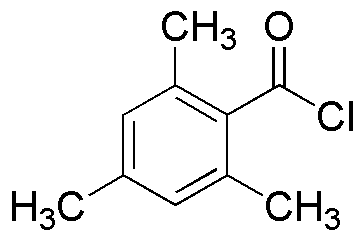2,4,6-Trimethylbenzoyl chloride is widely utilized in research focused on:
- Photoinitiators in Polymer Chemistry: This compound is commonly used as a photoinitiator in UV-curable coatings and inks, allowing for rapid curing processes which enhance production efficiency.
- Synthesis of Fine Chemicals: It serves as a key intermediate in the synthesis of various fine chemicals and pharmaceuticals, streamlining the production of complex organic molecules.
- Research in Material Science: The compound is applied in the development of advanced materials, particularly in creating high-performance polymers that require specific thermal and mechanical properties.
- Analytical Chemistry: It is utilized in analytical methods for detecting and quantifying other chemical compounds, providing researchers with reliable data for their studies.
- Cosmetic Formulations: The compound is also found in cosmetic formulations, where it acts as a stabilizer or preservative, enhancing product longevity and safety.
General Information
Properties
Safety and Regulations
Applications
2,4,6-Trimethylbenzoyl chloride is widely utilized in research focused on:
- Photoinitiators in Polymer Chemistry: This compound is commonly used as a photoinitiator in UV-curable coatings and inks, allowing for rapid curing processes which enhance production efficiency.
- Synthesis of Fine Chemicals: It serves as a key intermediate in the synthesis of various fine chemicals and pharmaceuticals, streamlining the production of complex organic molecules.
- Research in Material Science: The compound is applied in the development of advanced materials, particularly in creating high-performance polymers that require specific thermal and mechanical properties.
- Analytical Chemistry: It is utilized in analytical methods for detecting and quantifying other chemical compounds, providing researchers with reliable data for their studies.
- Cosmetic Formulations: The compound is also found in cosmetic formulations, where it acts as a stabilizer or preservative, enhancing product longevity and safety.
Documents
Safety Data Sheets (SDS)
The SDS provides comprehensive safety information on handling, storage, and disposal of the product.
Product Specification (PS)
The PS provides a comprehensive breakdown of the product’s properties, including chemical composition, physical state, purity, and storage requirements. It also details acceptable quality ranges and the product's intended applications.
Certificates of Analysis (COA)
Search for Certificates of Analysis (COA) by entering the products Lot Number. Lot and Batch Numbers can be found on a product’s label following the words ‘Lot’ or ‘Batch’.
Numéro de catalogue
Numéro de lot/série
Certificates Of Origin (COO)
This COO confirms the country where the product was manufactured, and also details the materials and components used in it and whether it is derived from natural, synthetic, or other specific sources. This certificate may be required for customs, trade, and regulatory compliance.
Numéro de catalogue
Numéro de lot/série
Safety Data Sheets (SDS)
The SDS provides comprehensive safety information on handling, storage, and disposal of the product.
DownloadProduct Specification (PS)
The PS provides a comprehensive breakdown of the product’s properties, including chemical composition, physical state, purity, and storage requirements. It also details acceptable quality ranges and the product's intended applications.
DownloadCertificates of Analysis (COA)
Search for Certificates of Analysis (COA) by entering the products Lot Number. Lot and Batch Numbers can be found on a product’s label following the words ‘Lot’ or ‘Batch’.
Numéro de catalogue
Numéro de lot/série
Certificates Of Origin (COO)
This COO confirms the country where the product was manufactured, and also details the materials and components used in it and whether it is derived from natural, synthetic, or other specific sources. This certificate may be required for customs, trade, and regulatory compliance.


